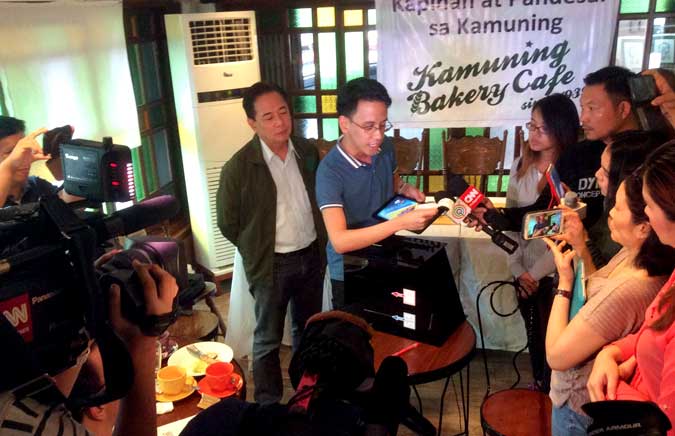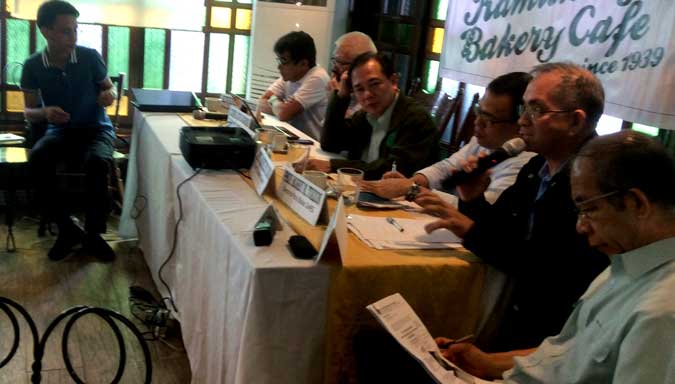CenPEG’s 2nd roundtable with media showcases TAPAT
Contributed by Christine Rimando
CenPEG
After the successful launch of its first Roundtable Discussion (RTD) with the Media on June 19, 2015, the Center for People Empowerment in Governance (CenPEG) held its second RTD last July 10, 2015 at the historic Kamuning Bakery Café in Quezon City. Adapting the same Kapihan at Pandesal theme, the event’s panel of speakers and IT technology developers discussed and demonstrated an alternative technology for the next and future automated elections in the country.
Among the resource persons were CenPEG’s policy analysts Dr. Temario C. Rivera and Prof. Bobby M. Tuazon, who also served as the forum moderator, AES Watch spokesperson Dr. Nelson J. Celis, former Comelec Comissioner Gus Lagman, AES Watch volunteer lawyer Manuelito Luna, and the persons behind TAPAT, Engr. Arnold Villasanta and son, Angelo.
TAPAT (or TrAnsPArenT Election System) was shown to the media in a short demo. The alternative election system is automated combining an Optimal Markup Reader for efficiency and Voter Verified Paper Audit Trail (VVPAT) with a receipt (that is afterward put in the transparent ballot box) and a partial/full transparency of vote counting.
The system uses a lotto-type ballot and works almost like it. This enables the voters to easily understand the mechanics of the machine. According to its developers, the GIS-specific TAPAT is a self-service machine which needs little help from the Board of Election Inspectors (BEI). Instructional messages are provided and screen messages guide voters to correct wrong ballot entries by the voter.
The process is easy and fast with the voter shading a ballot which corresponds to the candidates he/she will vote. Upon shading, the ballot will be positioned atop the machine for scanning. After scanning the ballot the machine will issue a receipt to verify if votes were counted correctly. The voter can change or correct votes thus minimizing spoiled ballots and eliminating additional time for replacement. After double checking the vote, both the ballot and the receipt will be dropped in the ballot boxes.
According to the TAPAT system designers, transparency is ensured because there is a platform for comparison between human-read and machine-read data. Corrections will be separated in different data compartments and changes will be tracked.
Verified and duly-authenticated election data will be transmitted securely. The voting center will receive the data by wireless transmission. Then the center will confirm who sent the transmitted data and who received it. The center will print a Precinct Election Return (PER) and saves the data in a storage. The voting center will gather all votes and transmit them to external servers, which will accumulate all votes from every voting center.
The system has also different security features to safeguard the process from any manipulation and fraud.
A TAPAT unit costs from P18,000 – P 20,000 which a lot cheaper compared to the Smartmatic’s Precinct Count Optical Scan (PCOS) machine which fetches P60,000 per unit. Besides, there will be no need to millions of maintenance and warehouse costs since all units can be donated to schools and other institutions after election, the Villasantas said.
The demonstration of alternative Filipino-designed election technologies is being organized under the Filipino IT for Election (FIT4E) movement launched in a national conference held at the University of the Philippines’ GT Toyota Center on June 13, 2011 by the Automated Election System Watch (AES Watch), a broad, multi-sectoral election policy advocacy and watchdog. FIT4E, composed of the country’s leading IT professionals groups, computer science schools, academics, and researchers, promotes the harnessing of Filipino science and technology to develop secure, credible, transparent, and law-compliant election systems.

Young TAPAT developer Angelo Villasanta (middle) shows media how to operate the machine, with Dr. Nelson Celis watching. CenPEG photo

Kapihan speakers (R-L): CenPEG chairperson Temy Rivera, Bobby Tuazon, Atty. Manny Luna, Nelson Celis, Gus Lagman, and Benjie Valbuena CenPEG photo
- Probing presidential platforms
- Conference calls for people-centered policy actions for Asian development and peace
- WWII 'comfort women' urge visiting Japanese emperor: OFFICIAL GOV’T APOLOGY, UPHOLD TRUTH, and JUST COMPENSATION
- FEARLESS FORECAST (EPISODE II): Comelec will not comply with e-Commerce Law in 2016 elections
- Fearless forecast: Comelec’s non-compliance with the AES law in 2016 (last of 2 parts)
- Fearless forecast: Comelec will not comply with the AES law in 2016
- CenPEG releases travelogue
- Experts: Nuisance bets reflect disillusionment, uneven playing field
- Partylist solon presses for tax cuts
- The True Cost of a Political Campaign
- Management decisions: Based on RA 9369 or purely Comelec’s?
- CenPEG holds 1st roundtable with media on presidential poll results
- Filipino IT can do it!
- FIT4E: The only transparent solution
- Realpolitik in the maritime tiff
- China’s challenge to PH sovereignty
- Choosing the next president
- Fixing the presidency, reforming the state
- New Comelec chair says he’s open to other election technologies
- SC ruling on AES Watch Pabillo and IBP vs Comelec, Smartmatic-TIM
- Comelec must explain P3.2B unliquidated cash advances
- CONGRESS ASKED TO HOLD DEMO ON PCOS HACKING
- 25 Bishops ask poll body to stop midnight deal with Smartmatic
- Pope Francis: reform and conversion
- 2 poll watch coalitions stage rally vs Comelec-Smartmatic midnight deal
- AES Watch questions Comelec-Smartmatic midnight deal
- ASEAN-India: Building Youth Partnerships through Culture and Entrepreneurship
- CenPEG forges research exchange and partnership with Jinan University
- FOI: Bearing fruit or foiled again?
- Remittance with Representation: The right to vote of overseas Filipinos
Center for People Empowewrment in Governance (CenPEG), Philippines. All rights reserved


